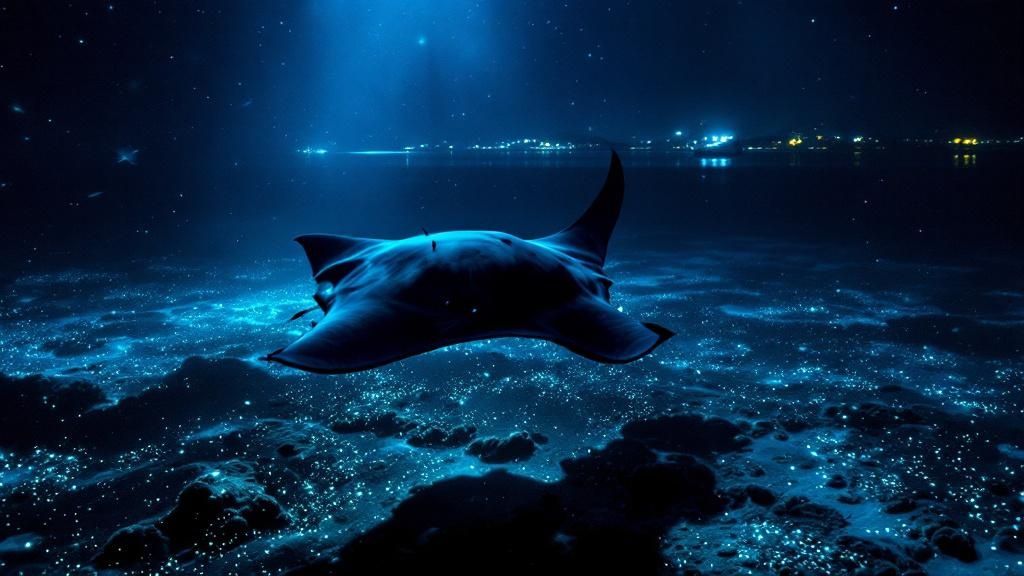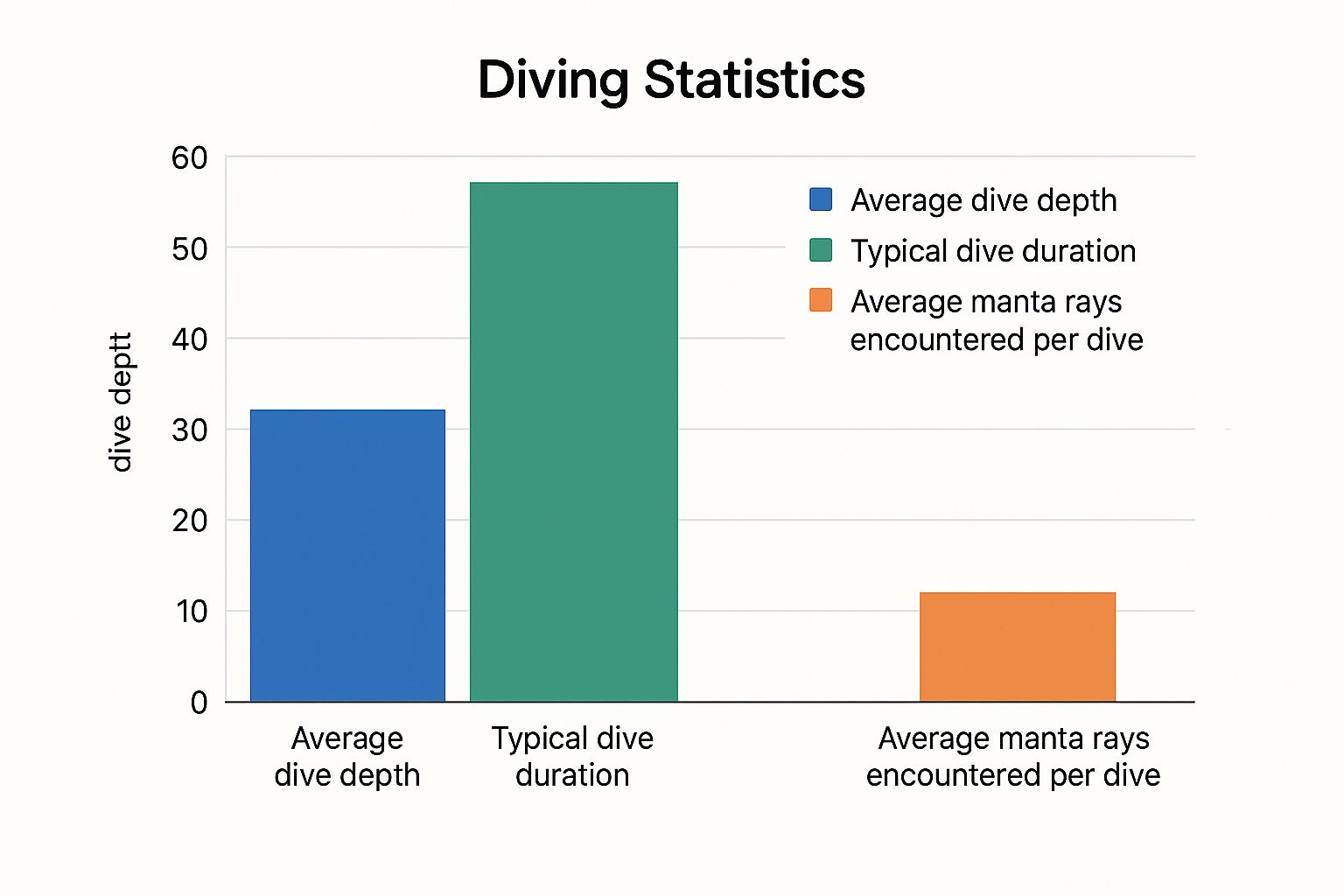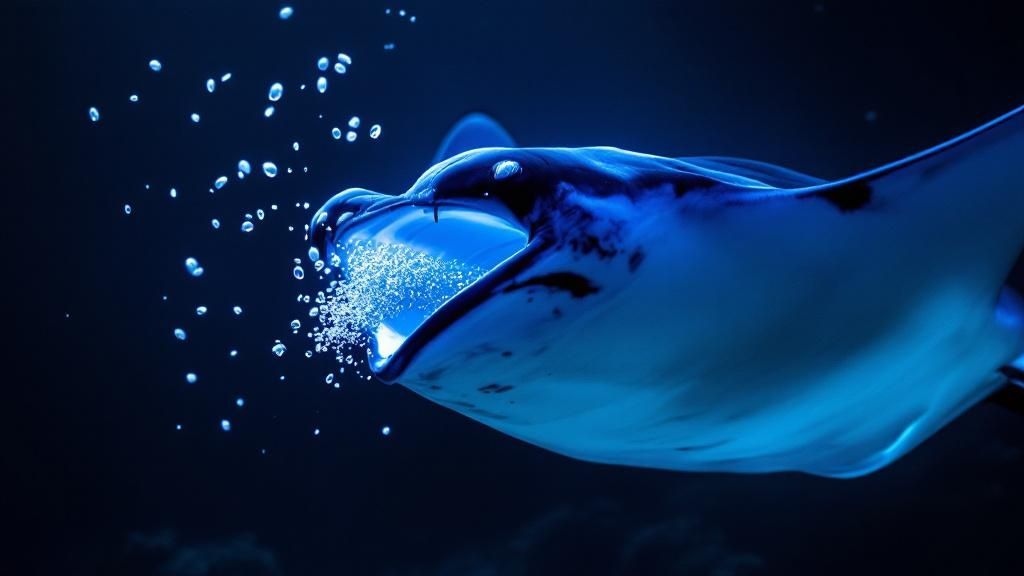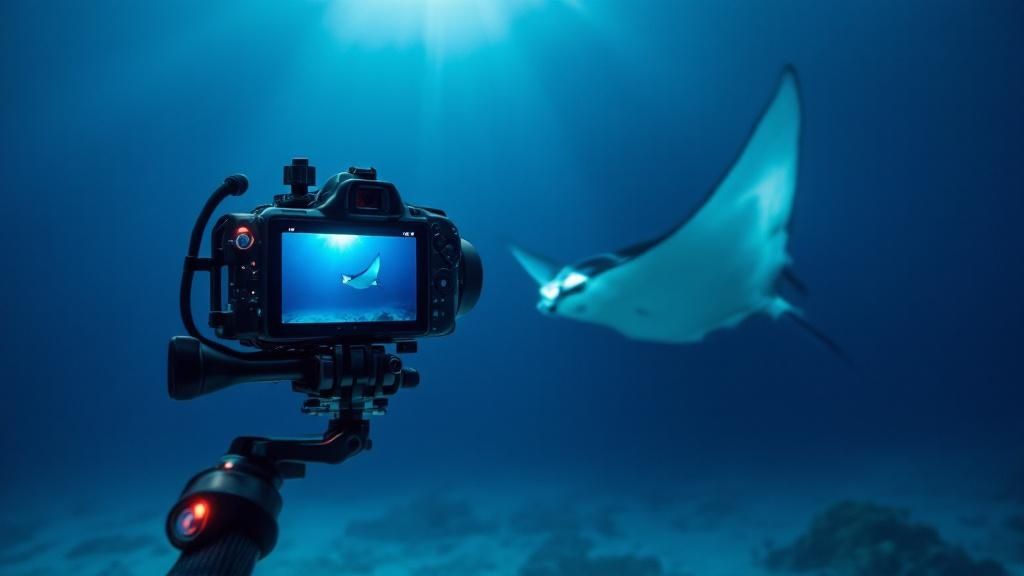Why Kona Delivers The World's Best Manta Ray Encounters
Kailua Kona is more than just a pretty place; it's the place to be for manta ray night dives. This isn't a coincidence. The island's unique volcanic geology has created deep channels and sheltered bays. These areas become concentrated with plankton, the manta ray's main food source. This naturally occurring phenomenon creates predictable feeding zones, consistently attracting these gentle giants. Divers and snorkelers can reliably witness these majestic creatures in their natural environment.
Nutrient-rich currents flowing along the Kona coast further enhance this plankton buffet. Combined with the volcanic slopes, these currents create a natural plankton trap, ensuring a constant food supply. This is a major reason why Kona boasts such a high success rate for manta ray sightings. Approximately 80,000 people participate in manta ray night dives in Kona, Hawaii each year. This popularity is driven by the high likelihood of sightings and the cultural significance of manta rays in Hawaiian tradition. Kona's unique ecosystem, with its shallow, protected bays acting as plankton traps, supports this consistent manta ray presence. These bays create predictable feeding grounds, attracting mantas to specific locations like Manta Village. For more detailed statistics, check out: Manta Ray Snorkel Kona Statistics.
Understanding Kona's Underwater Ecosystem
The underwater topography of Kona is fundamental to understanding the manta ray's feeding behavior. Locations like Manta Village and Manta Heaven act as natural funnels, concentrating plankton near the surface. Manta Village, for instance, is a shallow, protected bay, creating an ideal environment for plankton to flourish and, consequently, attracting mantas in large numbers. These predictable feeding areas make Kona an exceptional place for manta ray encounters. Learn more here: What is Manta Ray Night Dive.
Being well-rested is essential for a safe and enjoyable night dive experience. To help you prepare and fully appreciate this unique encounter, check out some tips on how to sleep better. The consistent sightings combined with the magic of a night dive truly make Kailua Kona an unforgettable destination for anyone wanting to experience these magnificent creatures.
Your Complete Manta Ray Night Dive Experience Revealed
Your manta ray night dive in Kailua Kona begins as the sun dips below the horizon. After a pre-dive briefing covering safety procedures and manta ray etiquette, you'll depart for one of Kona's renowned manta ray viewing sites. The anticipation builds as the boat approaches the dive location, usually either Manta Village or Manta Heaven.

Preparing for the Dive
Once at the site, your dive guide will help you prepare specialized equipment, including dive lights and, if necessary, wetsuits. Kona's waters are generally warm, but a wetsuit can provide extra comfort during the extended dive. These lights play a crucial role, attracting the plankton that forms the manta rays' primary food source. You might be interested in: Why Should You Go on a Manta Ray Dive in Kona?.
The Underwater Light Show
Entering the water, you'll descend to a designated area, often the sandy bottom, and create a semi-circle with your group. Powerful dive lights are directed upwards, creating an ethereal glow that attracts plankton. This underwater light show sets the stage for a breathtaking spectacle. As the plankton gather, so do the manta rays.
Manta Ray Encounters
Manta ray sightings in Kailua Kona are remarkably consistent. Dives experience an average success rate of 80% to 90% in encountering these magnificent creatures. This high success rate is attributed to Kona's unique underwater environment, which includes volcanic slopes and ocean currents that create an ideal habitat for plankton, the manta rays' primary food source.
You'll witness these graceful giants performing mesmerizing underwater ballets as they feed on the illuminated plankton. They glide effortlessly through the water, often coming incredibly close to the divers. Find more detailed statistics here. Expect encounters to last around 30-45 minutes, providing ample opportunity to observe their intricate feeding behaviors.
The Return and Reflection
After the manta rays have finished their feast and departed, you’ll ascend and return to the boat. Back on board, you'll have time to reflect on the incredible experience. Sharing stories and perhaps even reviewing photos or videos captured during the dive are common activities. The memories of this magical encounter will undoubtedly stay with you long after you leave Kona.
Choosing Between Garden Eel Cove And Keauhou Bay
Deciding on the perfect spot for a manta ray night dive in Kailua Kona often boils down to two fantastic options: Garden Eel Cove (Manta Heaven) and Keauhou Bay (Manta Village). Both offer amazing encounters, but understanding their distinct characteristics will help you select the best site for your dive. Two popular night dive sites in Kailua Kona are north of Kailua Kona by the Kona Airport and south of Kailua Kona at Keauhou Bay. The northern site, Garden Eel Cove, is often preferred for its proximity, protection, and higher average manta ray concentration. Discover more insights about manta ray locations.
Garden Eel Cove (Manta Heaven)
North of Kailua Kona, Garden Eel Cove is known for its frequent gatherings of larger manta ray groups. Read also: Manta Ray Heaven – Garden Eel Cove. While surface conditions can be slightly rougher than at Keauhou Bay, the potential reward is a truly spectacular display of multiple mantas feeding together.
Keauhou Bay (Manta Village)
South of Kailua Kona, Keauhou Bay provides calmer waters and easier access. While the manta ray groups might be smaller than those at Garden Eel Cove, the tranquil environment makes it perfect for first-time night divers or those susceptible to seasickness.
To help you visualize a typical manta ray night dive experience, take a look at the infographic below. It shows the average depth, duration, and number of manta rays you can expect to see.

This data highlights how accessible these dives are. With an average depth of 30 feet and a typical duration of 60 minutes, you’ll have plenty of time to observe the mantas. An average encounter of five manta rays per dive makes for a truly memorable experience.
To further compare these two prime dive locations, we've put together a helpful table summarizing their key features:
To help you make the best decision, the following table summarizes the key features of both dive sites:
Manta Ray Dive Site Comparison
Compare key features of the two main manta ray dive sites in Kailua Kona
| Feature | Garden Eel Cove | Keauhou Bay |
|---|---|---|
| Location | North of Kailua Kona | South of Kailua Kona |
| Manta Ray Groups | Often Larger | Can be Smaller |
| Water Conditions | Can be rougher | Calmer |
| Experience Level | Suitable for all levels, but better for experienced divers in rougher conditions | Ideal for beginners or those prone to seasickness |
| Accessibility | Boat access | Boat access |
As you can see, both sites offer unique benefits depending on your priorities.
Factors Influencing Site Selection
Ultimately, the best site for your manta ray night dive depends on a combination of factors:
-
Current Weather Conditions: Dive operators often base their final site decisions on current wind, wave, and visibility conditions.
-
Group Experience Level: The calmer waters of Keauhou Bay may be better for less experienced divers.
-
Individual Preferences: Some divers prioritize the potential for larger manta ray groups at Garden Eel Cove, while others prefer the tranquility of Keauhou Bay.
Strategic Planning For Your Perfect Manta Encounter
Planning a manta ray night dive in Kailua Kona is more than just booking a tour. It involves strategic planning, from picking the right time of year to selecting a reputable operator, to maximize your encounter with these gentle giants. This thoughtful approach ensures you have the best possible experience.
Timing Is Everything: Optimal Months and Moon Phases
Manta rays grace Kona's waters year-round, but some months offer superior viewing conditions. Generally, April to October boasts calmer seas and increased visibility, making for more comfortable and enjoyable dives. The moon phase also plays a role. Reduced moonlight enhances plankton visibility, encouraging manta feeding activity and increasing the likelihood of breathtaking displays.
Choosing Your Dive Operator Wisely
Selecting a reputable dive operator is paramount. Look for operators emphasizing sustainable tourism practices, a solid safety record, and experienced guides. Manta Ray Dive Kona – Underwater Nightclub is one example. Factors like group size, included amenities, and the availability of a “manta guarantee” are also important considerations for a safe and memorable night dive.
Preparing for Your Underwater Adventure
Preparation goes beyond selecting the right operator. Physical and mental readiness are essential. Be well-rested before your dive, and consider pre-dive dietary choices to prevent any discomfort.
Here’s a helpful checklist:
- Pack appropriately: A wetsuit is recommended for warmth, even in the warmer months.
- Capture the moment: Don't forget an underwater camera with low-light capabilities.
- Be prepared: Pack seasickness medication if you’re prone to motion sickness, and always communicate any concerns to your guide.
- Manage expectations: Remember that wildlife encounters are unpredictable, but proper planning will maximize your chances of a memorable experience.
Essential Dive Etiquette: Respecting the Gentle Giants
Maintaining proper dive etiquette is vital for both your safety and the manta rays' well-being. Never touch the mantas, as this disrupts their protective mucous layer. Avoid flash photography, which can disorient them. Always heed your guide’s instructions and control your movements to minimize disturbance. This respect ensures these magnificent creatures remain undisturbed in their natural habitat.

By following these strategies, you can elevate your manta ray night dive from simply memorable to truly unforgettable. You'll be well-prepared to appreciate the magic of these gentle giants in their natural environment. With careful planning, your manta ray encounter in Kailua Kona will be a treasured memory for a lifetime.
Supporting Manta Ray Research And Conservation Efforts
A manta ray night dive in Kailua Kona isn't just a thrilling adventure; it's a chance to contribute to vital research and conservation work. By participating, you directly support ongoing efforts to protect these gentle giants. This creates a strong link between responsible tourism and the long-term survival of this extraordinary natural phenomenon.
Tracking and Monitoring Manta Ray Populations
Dedicated researchers work tirelessly to understand the intricate lives of manta rays. They track individual mantas, identifying them by their unique spot patterns, much like fingerprints. This detailed work helps researchers monitor population dynamics, movement patterns, and overall health. For instance, they can learn about individual migratory routes and preferred feeding areas.
This information then informs sustainable tourism practices and helps protect vital manta ray habitats. Researchers also monitor health patterns and behaviors. This involves observing feeding habits, social interactions, and responses to human presence. This data offers invaluable insights into the population's well-being and helps identify potential threats.
Between 2009 and 2014, Manta Ray Advocates Hawaii collected detailed statistics on manta ray sightings at locations like Manta Village and Manta Heaven. Their efforts involved tracking individual manta rays, noting their physiological condition, and compiling monthly statistics. This data helped researchers understand manta ray behavior, travel patterns within their home range, and predict periods with higher manta activity. Find more detailed statistics here: Manta Ray Statistics.
Conservation Challenges and How You Can Help
Manta rays face several conservation challenges, including habitat degradation, entanglement in fishing gear, and the impacts of climate change. Responsible tourism plays a vital role in mitigating these threats. By choosing reputable dive operators committed to sustainable practices, you directly contribute to protecting these magnificent creatures. You might also be interested in exploring some of Kona's best snorkeling spots: Top 10 Kona Snorkeling Spots.
Ethical Diving Practices for a Sustainable Future
Ethical diving practices are essential for ensuring the long-term health of the manta ray population. Never touch a manta ray, as this disrupts their delicate mucous layer, which is vital for their immune system. Avoid sudden movements and maintain a respectful distance.
By following these guidelines, we minimize our impact and help preserve this incredible experience for future generations. Observing these graceful creatures in their natural habitat can be both awe-inspiring and beneficial for their continued survival. The balance between responsible tourism and conservation goals is delicate, but by working together, we can protect Kona's manta rays for years to come.
Maximizing Your Manta Ray Adventure Experience
Transforming your manta ray night dive in Kailua Kona from memorable to unforgettable involves preparation, the right equipment, and respect for these gentle giants. This guide, combining insights from underwater photographers and seasoned dive professionals, will help you make the most of your manta ray adventure.

Capturing the Magic: Underwater Photography Tips
Photographing manta rays at night presents unique challenges. With the right techniques, however, you can capture breathtaking images. Here are some tips to get you started:
-
Invest in a Quality Underwater Camera: Select a camera with robust low-light performance. A wide-angle lens will help capture the manta's impressive wingspan. Consider cameras from reputable brands like Canon or Nikon.
-
Master Your Camera Settings: Practice with various ISO levels and shutter speeds before your dive. This pre-dive practice will help you find the sweet spot between brightness and clarity in low-light conditions. A red filter can enhance colors during daytime dives.
-
Effective Lighting is Key: Position yourself strategically. The dive lights should illuminate the manta rays from below, creating a stunning contrast between their white underbellies and the dark water.
-
Patience and Observation: Manta rays are known for their unpredictable nature. Patience is key. Wait for the perfect moment to capture their graceful movements and unique feeding behaviors.
Dive Etiquette: Ensuring a Respectful Encounter
Responsible diving ensures a safe and enjoyable experience for both divers and the manta rays. Following these guidelines will minimize disturbance and help protect these magnificent creatures:
-
Maintain a Respectful Distance: Never touch a manta ray. Their skin has a protective mucous layer easily damaged by human contact.
-
No Flash Photography: The sudden burst of light from a flash can startle and disorient these gentle giants. Rely solely on the provided dive lights.
-
Controlled Movements: Avoid sudden movements or chasing the manta rays. Allowing them to approach you creates natural interactions and better photo opportunities.
-
Follow Your Guide's Instructions: Dive guides are experts on manta ray behavior and local conditions. Their instructions are essential for a safe and rewarding experience.
Beyond the Dive: Extending Your Manta Ray Adventure
The manta ray adventure doesn't end with the dive. Kailua Kona provides other activities to enrich your connection with Hawaiian marine life:
-
Daytime Snorkeling: Explore Kona's vibrant coral reefs and witness manta rays in daylight. Snorkeling offers a unique perspective, revealing color patterns and markings often missed during night dives.
-
Manta Learning Center: Deepen your understanding of manta ray biology, behavior, and conservation at the Manta Learning Center at the Sheraton Kona Resort.
-
Embrace Hawaiian Culture: Discover the deep connection between Hawaiian culture and the ocean by exploring local museums, cultural centers, or attending traditional ceremonies.
To help you plan your trip, here’s a handy guide detailing optimal times for manta ray encounters throughout the year:
Monthly Manta Ray Activity Guide
Best times throughout the year for manta ray encounters and what to expect
| Month | Activity Level | Conditions | Recommendations |
|---|---|---|---|
| January | High | Calm seas | Book in advance |
| February | High | Variable conditions | Check forecasts |
| March | Moderate | Possible rain | Pack accordingly |
| April | Moderate | Warming waters | Consider daytime dives |
| May | Moderate | Transition period | Flexible itinerary |
| June | High | Sunny skies | Ideal for snorkeling |
| July | High | Peak season | Book early |
| August | High | Warm waters | Excellent visibility |
| September | Moderate | Cooling waters | Fewer crowds |
| October | Moderate | Transition period | Pack layers |
| November | High | Calm seas | Great photo opportunities |
| December | High | Festive season | Combine with holiday activities |
This table summarizes the typical manta ray activity levels and conditions throughout the year. Remember, these are general trends, and actual conditions can vary. Always check local forecasts and consult with dive operators for the most up-to-date information.
By following these strategies, your manta ray night dive in Kailua Kona will become an unforgettable experience. You’ll be prepared to appreciate these gentle giants and contribute to their protection. Book your dive with Kona Honu Divers for an exceptional underwater adventure.
First-Timer's Guide To Manta Ray Night Diving Success
Embarking on a manta ray night dive in Kailua Kona is an unforgettable experience, especially for first-timers. This guide addresses common concerns, highlights safety protocols, and offers valuable insights to ensure your inaugural dive exceeds all expectations. For businesses looking to optimize their online presence, a well-defined conversion optimization strategy is also highly recommended.
Addressing Concerns About Night Diving
Many first-time night divers feel a sense of apprehension about entering the dark ocean. This is completely normal. However, reputable dive operators in Kailua Kona prioritize diver safety above all else. Highly trained and experienced dive guides provide clear instructions and maintain strict safety protocols, ensuring a secure and comfortable experience for everyone.
Understanding Certification and Fitness Requirements
While a specific "manta ray night dive" certification isn't mandatory, Open Water Diver certification is generally advised. This certification equips divers with fundamental scuba skills essential for a safe and enjoyable night dive. A reasonable level of physical fitness is also important. You should be comfortable swimming and treading water. Inform your dive operator of any physical limitations or health concerns prior to your dive.
Selecting the Right Tour Operator
Choosing the right tour operator is paramount. Look for operators with a proven track record of safety and sustainability. Factors such as group size, the guides' experience level, and customer reviews play a significant role in your decision-making process. Smaller groups often allow for more personalized attention from the guides.
Managing Underwater Anxiety and Exploring Alternatives
If you're still hesitant about diving, alternatives exist. Some operators offer snorkeling tours that run alongside the dive boats, providing a surface-level view of the manta rays. Don't hesitate to communicate any concerns to your dive guide. They can offer reassurance, provide personalized guidance, and help manage any anxieties during the dive.
Tips for a Successful First Dive
Here are a few tips to maximize your first manta ray night dive:
- Communicate with your guide: Share any concerns or anxieties openly.
- Focus on your breathing: Slow, deep breaths are key to regulating anxiety and staying calm underwater.
- Stay close to your guide: This provides an added layer of security and comfort.
- Enjoy the experience: Relax and marvel at the breathtaking spectacle of the manta rays feeding.
Book your unforgettable manta ray night dive adventure with Kona Honu Divers today!
